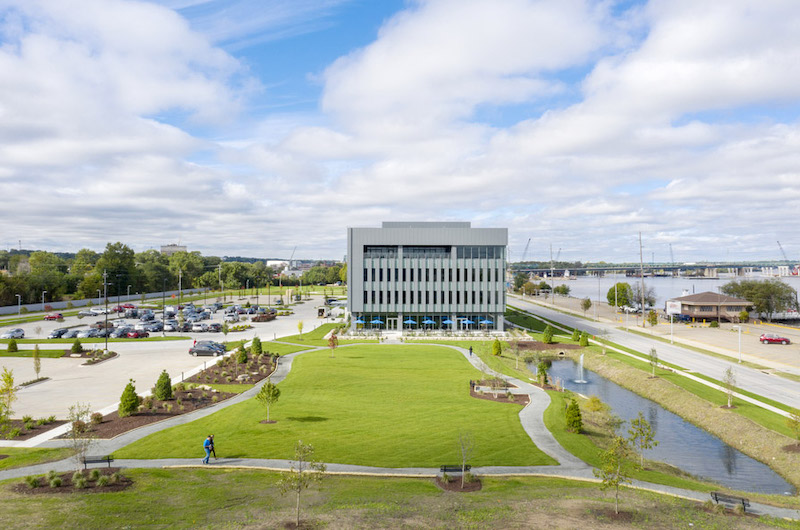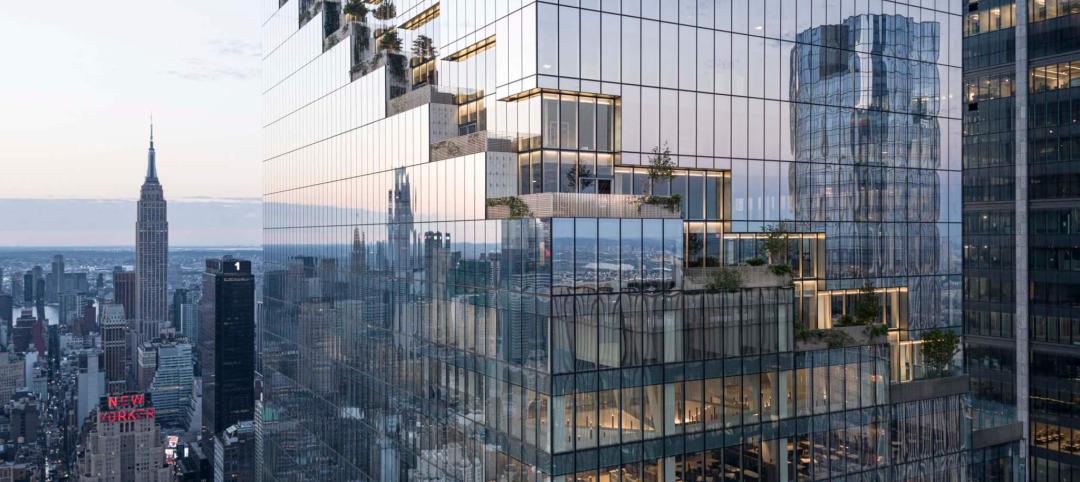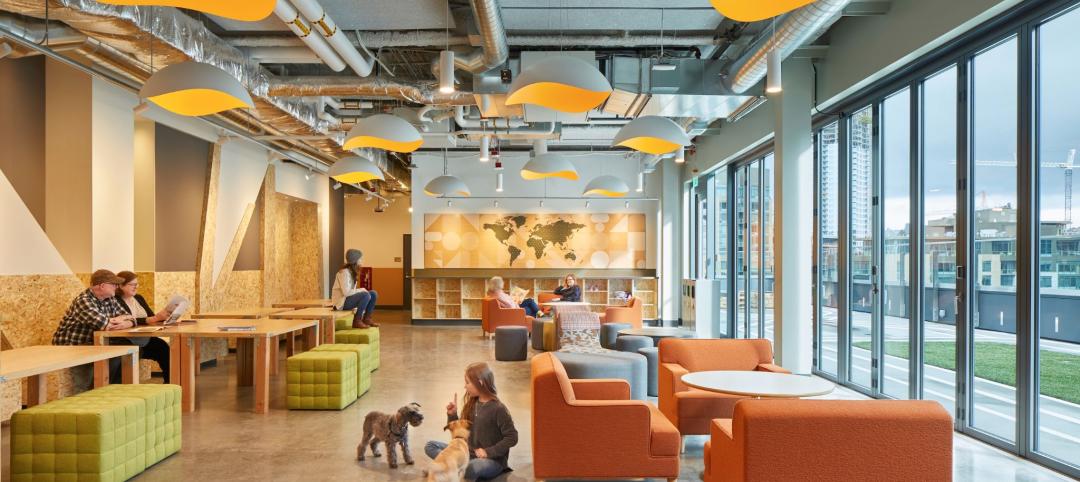You’ve made the jump. You took the risk and have officially set out alone, swimming against the current in an overwhelming sea of large corporations. Your ideas get legs, even take flight, and your workload begins to demand an ever-growing crop of new talent. You beef up your compensation offerings and benefits packages. You move into a new space and add a slew of amenities to attract the best and brightest in the industry. What could possibly go wrong?
For companies experiencing rapid growth, work-life balance can be a challenge to maintain, yet it remains a vital aspect of a healthy work environment.
There is an opportunity to create social opportunities within the workplace, while offering simple gestures that allow employees to more efficiently accomplish day-to-day life, customized to each individual.
Our workplace team at LEO A DALY aims to shape physical environments to allow these features to thrive. However, at the end of the day, many amenities are truly operational in nature and rely heavily on an owner’s long-term commitment.
As you set out on your quest to provide every available amenity to your employees, it can be overwhelming. We recommend prioritizing your desired amenities and considering the following principles to help employees maintain a healthy balance.
Redefine the traditional view of work-life balance
We spend a lot of time in our jobs. The 40-hour work week no longer exists. In fact, in today’s workplace, there is no longer such a thing as “after work.” Employees’ lives can exist largely within the office, or they can work remotely from home with little-to-no direct interaction with their co-workers.
Definitions of work-life balance are numerous and vary widely. This balance has been traditionally perceived as having equal time committed to work, family, hobbies, outside social events, etc. – doing whatever it takes to accomplish all things for all people. However, this balance is truly individualized. It is driven by each person and will vary over time, sometimes every day. The right balance for one employee will seem absurd to someone else. The right balance today may be different tomorrow.
Most importantly, striking that perfect balance has undeniable health benefits. Overly stressed employees can become susceptible to workplace burnout, increasing the potential for disengagement, errors, accidents, sick leave and eventually high turnover rates. To combat stress, service-based amenities can help employees reduce demands on their time. Social amenities can brighten their days, providing interaction and engagement. When employees feel balanced (by their own definition), they will be happy, healthy, productive and a shining example to recruit new top talent.
Understand the difference between service-based and social amenities
Service-based amenities make life a little easier. They are conveniences that would otherwise take time away from our day. They allow life to happen outside the workplace.
- During site selection, plan for access to public transportation.
- Coordinate internal ridesharing programs.
- Offer powerful Wi-Fi for untethered collaborative working.
- Strategically arrange healthy food selections for breakfast, lunch and dinner.
- Provide reusable flatware, plates and water bottles with filling stations throughout.
- Provide a staff concierge service for mail service and package delivery/reception, dry cleaning, last-minute grocery needs, airport travel.
- Staff a full-time handyman to complete odds and ends at employees’ homes, reducing the stress of at-home coordination.
- Set aside space for dedicated lactation rooms for new mothers and quiet rooms for private matters, no questions asked.
- Investigate childcare options: internal daycares, subsidizing nearby daycare centers.
- Provide temporary pop-up specialties: barber, hair stylist, clinic/health assessment services.
Social amenities are engaging, bringing people together to create a vibrant work culture. They activate interaction between employees, and potentially invite the community to join the experience. Employees engaged in their community only strengthen your culture. They create life inside the workplace.
- Activate common break areas with nearby circulation and seating variety.
- Provide coffee and other beverage options in common spaces to start the morning.
- Boost Wi-Fi capacity, and allow connectivity to personal devices.
- Create large multi-purpose spaces and encourage use by community groups.
- Integrate spaces for activity: gym equipment, group fitness, multi-purpose space, outdoor walking trails.
- Offer access to an on-site staff trainer and instructed classes.
- Provide locker rooms with showers and changing facilities.
- Create recreation spaces with video games, simulators, pool tables, foosball, etc.
- Incorporate a theater room.
- Provide access to snacks and beverages, alcoholic and otherwise.
- Partner with local retailers for ground-level access to coffee shops, boutiques, eateries, etc.
Designing for balance
You know your people, and you are the subject matter expert as we begin our work. LEO A DALY’s workplace team has the privilege to listen and learn about a new process with each new client. Direct collaboration with you leads to design for the right variety of service-based and social amenities, customized to your specific workplace culture. We craft experiences and curated views of workplace features. We create spaces that are flexible to adapt to new trends.
As you grow, be smart and prioritize the conveniences you offer, find the right mix of service and social perks to fit your culture and encourage employees to break the mold as they find their perfectly customized work-life balance. Healthy employees make for healthy companies.
Related Stories
Biophilic Design | Jan 16, 2024
New supertall Manhattan tower features wraparound green terraces
At 66 stories and 1,031.5 ft high, The Spiral is BIG’s first supertall building and first commercial high-rise in New York.
Sustainability | Jan 10, 2024
New passive house partnership allows lower cost financing for developers
The new partnership between PACE Equity and Phius allows commercial passive house projects to be automatically eligible for CIRRUS Low Carbon financing.
MFPRO+ Special Reports | Jan 4, 2024
Top 10 trends in multifamily rental housing
Demographic and economic shifts, along with work and lifestyle changes, have made apartment living preferable for a wider range of buyers and renters. These top 10 trends in multifamily housing come from BD+C's 2023 Multifamily Annual Report.
Green | Dec 18, 2023
Class B commercial properties gain more from LEED certification than Class A buildings
Class B office properties that are LEED certified command a greater relative benefit than LEED-certified Class A buildings, according to analysis from CBRE. The Class B LEED rent advantage over non-LEED is about three times larger than the premium earned by Class A LEED buildings.
Office Buildings | Dec 12, 2023
Transforming workplaces for employee mental health
Lauren Elliott, Director of Interior Design, Design Collaborative, shares practical tips and strategies for workplace renovation that prioritizes employee mental health.
Office Buildings | Dec 11, 2023
Believe it or not, there could be a shortage of office space in the years ahead
With work-from-home firmly established, many real estate analysts predict a dramatic reduction in office space leasing and plummeting property values. But the high-end of the office segment might actually be headed for a shortage, according to real estate intelligence company CoStar Group.
Transit Facilities | Dec 4, 2023
6 guideposts for cities to create equitable transit-oriented developments
Austin, Texas, has developed an ETOD Policy Toolkit Study to make transit-oriented developments more equitable for current and future residents and businesses.
Office Buildings | Dec 1, 2023
Amazon office building doubles as emergency housing for Seattle families
The unusual location for services of this kind serves over 300 people per day. Mary's Place spreads across eight of the office's floors—all designed by Graphite—testing the status quo for its experimental approach to homelessness support.
Engineers | Nov 27, 2023
Kimley-Horn eliminates the guesswork of electric vehicle charger site selection
Private businesses and governments can now choose their new electric vehicle (EV) charger locations with data-driven precision. Kimley-Horn, the national engineering, planning, and design consulting firm, today launched TREDLite EV, a cloud-based tool that helps organizations develop and optimize their EV charger deployment strategies based on the organization’s unique priorities.
Market Data | Nov 27, 2023
Number of employees returning to the office varies significantly by city
While the return-to-the-office trend is felt across the country, the percentage of employees moving back to their offices varies significantly according to geography, according to Eptura’s Q3 Workplace Index.

















